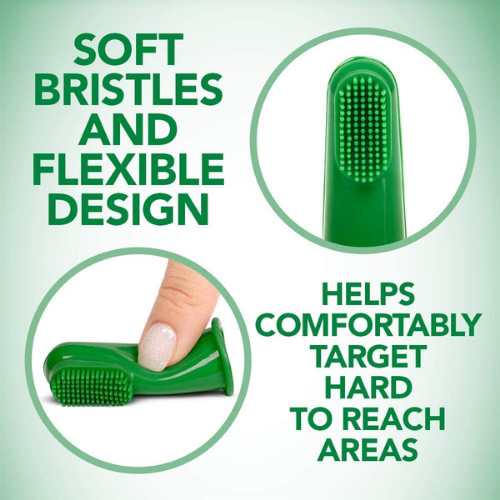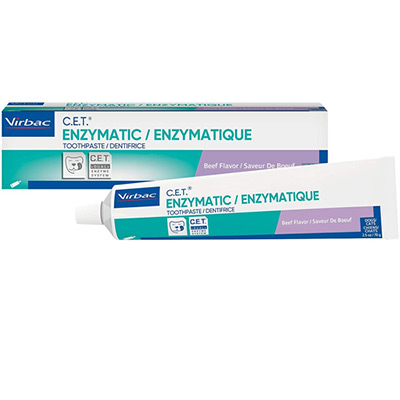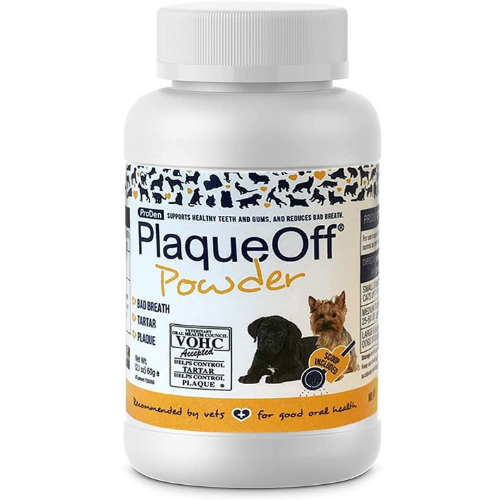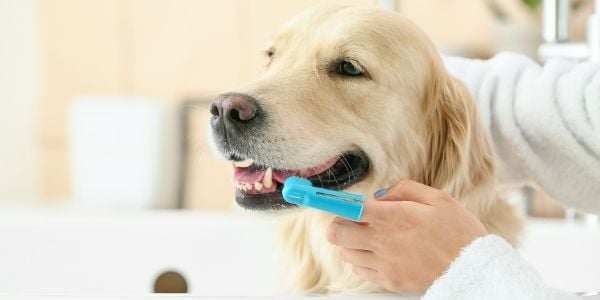 With periodontal disease being one of the leading diseases affecting a dog's health these days, dental care should become an extremely important part of your pet's regular health routine.
With periodontal disease being one of the leading diseases affecting a dog's health these days, dental care should become an extremely important part of your pet's regular health routine.
Dental care is essential from the moment your dog gets their permanent adult teeth, but introducing your puppy to toothbrushing when they're young makes the process easier.
Now, let's face it, even as a veterinarian, I don't brush my dog's teeth every day, even though I should!
If you can do it 3 to 4 times a week, that would go a long way in helping your dog stay healthy. If you want to know why brushing is so important, I go through this at the end of this article, along with some recommended products that are best suited for dogs.
Let's get down to the "how-to" of brushing your dog's teeth.
How to Brush Your Dog's Teeth
It is important to ease your pup into a daily tooth-brushing routine. We're going to break down how to best way to do so.
- Start by getting your dog comfortable with your hands being near their mouth — don't jump into using a toothbrush right away.
- Start by using a treat. Put a small amount of natural peanut butter, some of your dog's wet food, or low-fat cottage cheese (or a similar dog-friendly snack) on your index finger, call your dog to you, and let them lick it off.
Do this 1 to 2 times a day for 3 to 5 days. The closer you can have your finger to their mouth while they are comfortable, the better. - Next, call your dog to you and give them a regular treat. Then, gently lift their lip and briefly touch your finger to their gums and teeth. Follow this with a treat as a reward.
If your dog is comfortable with this, you may repeat this 2 times a day for 7 to 10 days. Keep sessions under 2 minutes, and always be gentle. Never approach them when they are asleep or dozing and aren't aware that you are coming. - When your dog is comfortable with you raising their lip and touching their teeth and gums, it’s time to add in toothpaste.
Do not use human toothpaste as it can be toxic to pets. Instead, use a toothpaste made for dogs and cats.
The best part is pet toothpaste is designed to be tasty to dogs (think beef or chicken flavors), and it's made to be swallowed, unlike human toothpaste. See further below for some veterinary-recommended toothpaste choices.
- Let your dog sniff and lick the toothpaste from your finger, and if they'll allow, place some toothpaste on their teeth or gums for them to lick off. You can start to gently rub with the toothpaste if your dog will allow it.
Repeat this process 1 to 2 times a day for 5 to 7 days until your pooch is very comfortable, perhaps even begging for the toothpaste treat! - If your dog gets too excited about their toothpaste “treat” and starts to nibble too hard on your finger, stop and remove your finger from their mouth and hide it behind your back. Ask them for a cue they know well, such as sit.
Even better, if they know the gentle cue to take treats with a softer mouth. If they can’t settle down, try again later when they are a bit more tired and relaxed.
Take it Slow and Go at Your Dog's Pace
During this entire process, always pay attention to your dog's behavior. Don't ignore any signs of discomfort, agitation, or avoidance, as this will only create a negative association with the experience.
It's ok to stop if you feel they are uncomfortable or not accepting of the process right now and come back to it later. Pushing them to tolerate it is not the answer.
You will get further will slow positive repetition.
If your dog exhibits signs of aggression or fear while trying to introduce toothbrushing, connect with a certified dog trainer for help with cooperative care training.
PRO TRAINER TIP: To make teeth brushing even easier, it can be helpful to teach your dog a chin rest. This cue is where your dog rests their chin on your open palm or other target (like a towel on your lap) and stays there.
This is especially helpful for dogs who avoid hands reaching for their face and creates a much more cooperative experience. It's also really helpful for veterinary visits.
This video shows how to train a chin rest as part of the overall teeth brushing routine.
How to Use a Finger Toothbrush to Brush Your Dog's Teeth
Once your pup is comfortable with all the steps above, it's time to introduce a finger toothbrush. This is a small 'thimble-like' brush that goes over your finger, allowing you to gently brush your pet's teeth.
It's recommended you break up the brushing into 4 different segments to give your pup a break and not overwhelm them and to continue to make this a positive experience while they are learning to enjoy this new habit!
This four-segment approach also corresponds with the four quadrants of your dog's dentition.
For example, you can start with the upper right side, then stop and reward, move to the upper left side, stop and reward, then lower left side, and finally then lower right. You don't have to do it exactly in this order but use this as a guide.
Start by placing a small amount of pet-safe toothpaste on the finger toothbrush and gently introduce the toothbrush into your dog's mouth. They may want to lick the toothpaste off and sniff the toothbrush, and both are ok!
Remember, slow and steady wins the race. If they're comfortable with you touching their teeth and/or gums with the finger toothbrush, start trying to gently brush in small circles.
You want to brush the outside of your dog's teeth, aiming toward the gum line, which is where dental disease usually starts. Aim for up to 30 seconds on each side (but start with just a few seconds at a time until your dog is comfortable).
Make sure to reward them verbally and with treats during and after. I like to start on the canine teeth, as there is more surface area, and the lip is generally easier to move in this area.
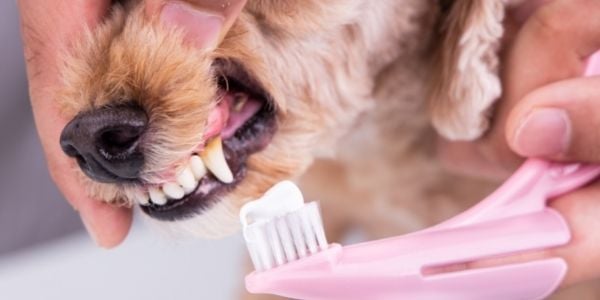
After a few sessions, if your dog is doing well, you can graduate to a larger doggy toothbrush! However, if you need to stick with a finger toothbrush, that's fine, too.
Many dogs find that a long toothbrush is a fun chew toy compared to a finger brush.
Repeat the same process with the doggy toothbrush as with the finger brush.
For a toothbrushing, demonstration check out this video.
How Often Should You Brush Your Dog's Teeth?
Per the Veterinary Oral Health Council (VOHC), it is recommended that you brush your dog's teeth daily. This is because plaque settles on their teeth each day (just like our teeth) from regular activities such as eating, chewing, grooming, etc.
And tartar, which forms from their saliva and calcium deposits, attaches to the plaque on the tooth surface and starts to build up rapidly, leading to severe dental disease before we know it.
If you can't brush every day, try to do it several times a week and provide dental chews or additives to your dog's food or water to help keep plaque at bay.
Our Recommendation for Dog Brushing & Oral Health Tools
What Type of Toothbrush Should You Use?
There are several types of toothbrushes that can be used to brush your dog's teeth.
Some of the most common include a finger brush, pet toothbrush, or even a small human toothbrush with soft or extra-soft bristles.
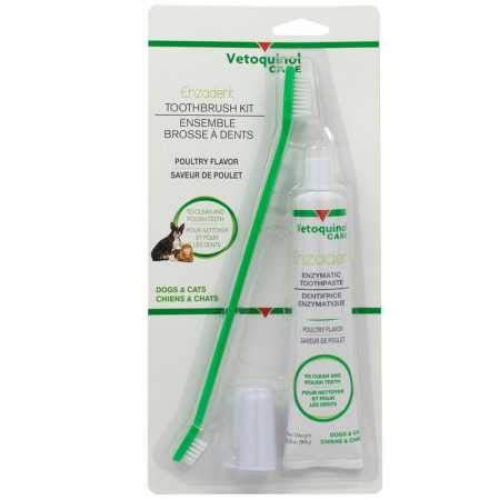
Can you use an electric toothbrush to brush your dog's teeth?
There are a few reasons I don’t recommend using an electric toothbrush when attempting to brush your dog’s teeth.
1. The first is that the noise may scare them and undo all the hard work you have just done on training them to tolerate brushing in the first place. Even though you can work them up to the noise, it will still most likely be terrifying for a dog.
Most dogs aren’t fans of strange noises and moving objects (read: the vacuum!), and unless you have a very well-behaved and well-trained dog, then I highly suspect they aren’t going to take to the noise of an electric toothbrush exceptionally well, especially when they can’t visualize it while it’s in their mouth.
2. Next, an electric toothbrush spins much faster and harder than your hand or finger can and, therefore, can cause damage to the soft, sensitive gums and/or even your dog’s tongue if you are to press even slightly too hard.
Now, when we brush our own teeth with an electric toothbrush, we can judge exactly how much pressure to apply as our brain will tell us when it hurts or it doesn’t feel comfortable.
However, your dog cannot tell you that; instead, they may nip, bite or react negatively to any form of discomfort this kind of toothbrush may cause.
Ultimately, you are better off being able to control the speed and pressure with your own hand or finger using a regular toothbrush or finger brush, as you are much less likely to cause undue trauma and adverse reactions from your dog!
What Type of Toothpaste Should You Use for Your Dog?
Human toothpaste should never be used for your dog. Some of these toothpastes contain toxic substances, such as xylitol (often used in human dental products), as well as fluoride, which is highly toxic to dogs in large doses.
Additionally, human toothpaste is not designed to be swallowed.
Sodium Lauryl Sulfate (SLS) which causes the foaming that occurs when we brush our teeth with toothpaste, can cause gastrointestinal upset in dogs if swallowed — it’s difficult enough to get a four-year-old to rinse and spit, let alone a Corgi!
And most human toothpastes come in flavors that are unpleasant to dogs.
Instead, use toothpaste specifically designed for dogs! It's safe to eat, and most dogs enjoy the taste.
Enzymatic toothpaste for pets
These specific toothpastes contain enzymes that help to break down the plaque on teeth and the microbial atmosphere that allows it to form on the teeth, ultimately reducing the bacterial load and tartar build-up.
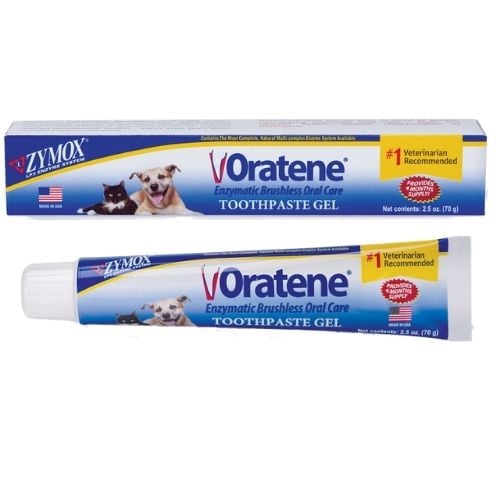
Dog Dental Treats
Just like we are supposed to floss and use oral rinses in addition to brushing, there are extras you can give your pet.
Giving dental treats that have a Veterinary Oral Health Council (VOHC) seal of approval ensures that the treat is certified to retard plaque and tartar on the dog's teeth.
Some of our dog's favorite dental treats are: Whimzees Natural Dental Chews and Purina Dental Chewz, but you can also check VOHC's list for more dental product choices.
Food Additives to Help With Dental Health
Dental food additives can be a great addition to regular tooth brushing to help reduce the accumulation of plaque on your dog’s teeth.
The idea is, that the food additives will already be on your dog’s teeth ready to fight the microbiomes that form plaque and help break them down before they can harden and attach to the tooth's surface.
However, additives shouldn’t replace regular tooth brushing or dental check-ups with your dog’s veterinarian.
Water Additives & Gels to Help With Oral Health
Some pets don't chew their food well, have food sensitivities, or just don't like treats. So, you can have an alternative with oral health water additives that also help protect their teeth.
For example, you can add Oratene water additive to their drinking water.
There's also this antiseptic gel that contains a potent enzyme that aids in the treatment of gingivitis and periodontal disease. It soothes and relieves inflamed gums.
Why Brushing Your Dog's Teeth Is Important?
Just like humans, a dog's oral health affects their overall well-being. By tending to your pet's teeth, you can help prevent tooth loss, dental disease, gingivitis, and other serious health issues.
Plaque — a thin film on the teeth — accumulates due to food and saliva buildup. This film can be removed by brushing. Left untreated, plaque hardens into tartar, which is much harder to remove.
Plaque and tartar accumulation leads to periodontal disease, a condition affecting not only the teeth but also the structures around them (the gums, periodontal ligament that holds the tooth in place, and even the jawbone).
This can lead to extreme pain and inflammation inside your dog's mouth.
The bacteria in the mouth and in dental plaque irritate the gum if plaque is allowed to accumulate. It can result in infection of the tissues and in the bone surrounding the teeth.
Additionally, this bacteria can enter the bloodstream through these inflamed gums, and lead to serious infections of various organs, and cause severe organ dysfunction or even infection of the whole body (septicemia).
For example, important organs such as the liver and heart are particularly prone to becoming inflamed as a result of the bacteria and microbiomes from dental disease. So, your dog's mouth really does directly affect their whole body.
You can help to remove plaque and prevent periodontal disease by brushing your pup's teeth daily. But if you absolutely can't brush their teeth, you can try an oral rinse, like Virbac's Aquadent.
I usually recommend putting it in a syringe so you can easily apply it to your dog's mouth.
It is recommended, just like it is for people, to have your dog's teeth cleaned every 6 to 12 months. While their teeth may look ok, there are possible issues hiding below the gum line.
This is why a full oral exam under anesthesia and dental radiographs are so important.


